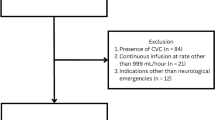Summary
The effects on epidural bleeding of two major factors were studied in a swine model. These were detachment of the dura from the skull and an epidural arteriovenous shunt. Firstly the effect of differing degrees of detachment of dura was studied in the absence of a shunt. Secondly the effect of the shunt was examined with a constant degree of dural detachment.
Increasing the degree of the detachment of the durai from the skull increased the rate and volume of bleeding. In addition the greater the degree of durai detachment from the skull the easier it was for further dura stripping to take place. The shunt reduced the epidural pressure and increased the bleeding pressure. Sometimes it reduced the force which, acting on the dura would strip more dura free, but never enough to preclude further dura stripping. Larger shunts were associated with a longer bleeding duration.
It is concluded that the effects of dura detachment and the epidural shunt acting in concert can explain the delayed expansion of an epidural haematoma and are consistent with the known variability of clinical epidural haematomas.
Similar content being viewed by others
References
Bell C (1816) Surgical observations. Longman, Hirst, Rees, London, p 166
Bricolo AB, Pasut LM (1984) Extradural hematoma: towards zero mortality — a prospective study. Neurosurgery 14: 8–12
Campbell JB, Cohen J (1951) Epidural hemorrhage and the skull of children. Surg Gynecol Obstet 92: 257–280
Cordobes F, Lobato RD, Rivas JJ, Munoz MJ, Chillon D, Portillo JM, Lamas E (1981) Observations on 82 patients with extradural hematoma. J Neurosurg 54: 179–186
Dhellemmes P, Lejeune J-P, Christiaens J-P, Combelles G (1985) Traumatic extradural hematomas in infancy and childhood. J Neurosurg 62: 861–864
Ericson K, Håkonsson S, Løfgren J, Zwetnow NN (1979) Extravasation and arteriovenous shunting after epidural bleeding: a radiological study. Neuroradiology 17: 239–244
Ford LE, McLaurin RL (1963) Mechanisms of epidural haematomas. J Neurosurg 20: 760–769
Gallagher JP, Browder EJ (1968) Extradural haematoma — experience with 167 patients. J Neurosurg 29: 1–12
Greenburg J, Cohen WA, Cooper PR (1985) The “hyperacute” extraaxial intracranial haematoma: computed tomographic findings and clinical significance. Neurosurgery 17: 48–55
Habash AH, Sortland O, Zwetnow NN (1982) Epidural hematoma: pathophysiological significance of extravasation and arterio-venous shunting. An analysis on 35 patients. Acta Neurochir (Wien) 60: 7–27
Habash AH, Zwetnow NN, Ericson H, Løfgren J (1983) Arteriovenous epidural shunting in epidural bleedings — radiological and physiological characteristics. An experimental study in dogs. Acta Neurochir (Wien) 63: 291–313
Helmer FA, Sukoff MH, Plaut MR (1968) Angiographic extravasation of contrast medium in an epidural hematoma. J Neurosurg 29: 652–654
Hooper R (1959) Observations on extradural haemorrhage. Br J Surg 47: 71–87
Jacobsen WHA (1885) On middle meningeal haemorrhage. Guys Hosp Rep 43: 147–308
Jamieson KG, Yelland JDN (1968) Extradural hematoma — report of 167 cases. J Neurosurg 29: 13–23
Lobato RD, Rivas JJ, Cordobes F, Alted E, Perez C, Sarabia R, Cabrera A, Diez I, Gomez P, Lamas E (1988) Acute epidural hematoma: an analysis of factors influencing the outcome of patients undergoing surgery in coma. J Neurosurg 68: 48–57
Løfgren J, Zwetnow NN (1972) Kinetics of arterial and venous hemorrhage in the skull cavity. Intracranial Pressure 2: 155–159
Løfgren J, Zwetnow NN (1972) Experimental studies on the dynamic course of intracranial arterial bleeding. Acta Neurol Scand 48: 252
McClaurin BL, Ford LE (1964) Extradural hematoma statistical survey of forty-seven cases. J Neurosurg 21: 364–371
McKissock W, Taylor JC, Bloom WH, Till K (1960) Extradural hematoma: observations on 125 cases. Lancet 2: 167–172
Mealey J (1960) Acute extradural hematomas without demonstrable skull fractures. J Neurosurg 17: 27–34
Pang D, Horton JA, Herron JM, Wilberger JE, Vries JK (1983) Nonsurgical management of extradural hematomas in children. J Neurosurg 59: 958–971
Petersen OF, Espersen JO (1984) How to distinguish between bleeding and coagulated extradural hematomas on the plain CT scanning. Neuroradiol 26: 285–292
Vaughan BF (1959) Middle meningeal haemorrhage demonstrated angiographically. Br J Radiol 32: 493–494
Weinman DF, Muttukumaru B (1968) The mortality from extradural haematoma. Aust NZ J Surg 38: 104–107
Zimmerman RA, Bilaniuk LT (1982) Computed tomographic staging of traumatic epidural bleeding. Radiology 144: 809–812
Zuccarello M, Fiore DL, Pardatscher K, Trincia G, Ancrioli GC (1983) Chronic epidural haematomas. Acta Neurochir (Wien) 67: 57–66
Zwetnow NN, Habash AH, Løfgren J, Håkonsson S (1983) Comparative analysis of experimental epidural and subarachnoid bleedings in dogs. Acta Neurochir (Wien) 67: 67–70
Zwetnow NN, Schrader H, Løfgren J (1986) Effects of continuously expanding intracranial lesions on vital physiological parameters. An experimental animal study. Acta Neurochir (Wien) 80: 47–56
Author information
Authors and Affiliations
Additional information
This paper has been supported by the Norwegian Society for Combatting Cancer, The University of Oslo, The Anders Jahre Foundation for The Advance of Research and by Carl Sembs Research Foundation, Oslo.
Rights and permissions
About this article
Cite this article
Ganz, J.C., Zwetnow, N.N. Analysis of the dynamics of experimental epidural bleeding in swine. Acta neurochir 95, 72–81 (1988). https://doi.org/10.1007/BF01793086
Issue Date:
DOI: https://doi.org/10.1007/BF01793086




